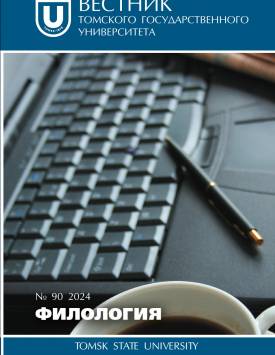Traditions of the English sensation novel in Leo Tolstoy’s works. Article One. Mary Elizabeth Braddon’s Aurora Floyd and its role in the creation of War and Peace
The article aims to prove that Leo Tolstoy used the traditions of the English sensation novel in developing the characters and plot of War and Peace. The diaries and letters show that he was actively interested in the writings of Mary Elizabeth Braddon during the period of work on the first parts of the novel, particularly emphasising her Aurora Floyd. Working on the complex genre construction of War and Peace, in which historiosophic speculations had to be balanced by a fascinating novel plot, Tolstoy needed examples of how to create “the interest of the combination of events” (a quote from his diary). On the basis of a comparative analysis with the Aurora Floyd novel, it is shown that it was the sensation novel that helped Tolstoy to give dynamics and tension to the plot, to complicate the characters’ images, to strengthen their psychological credibility. The article traces how Tolstoy used the motif of “solving the mystery” from Braddon’s novel, developing the character of Helene. By doing so, he deepened the contrast between the character’s popularity in the world and her inner emptiness. At the same time, the writer created the effect of playing with stereotypes, which is also characteristic of Braddon, and made the outwardly beautiful, “light” female image absolutely immoral. The techniques of the sensation novel that allow Tolstoy to show the vicious nature of the Kuragin family, which is emphasised through the motifs of incest and bigamy. The author of the article proves that Braddon’s innovation - first of all, her audacious demonstration of the passionate, impetuous character of Aurora Floyd in interaction with male characters - helps Tolstoy in forming the character of Natasha Rostova: he deliberately makes her actions go beyond the standards. The characters of the aristocrat Bulstrode and Prince Bolkonsky are resembling: the writers equally demonstrate how the noble pride of the characters covers their spiritual limitations and adherence to stereotypes. The article pays special attention to the influence that the sensation novel had on the development of the main plot “node” of War and Peace. In the scenes of Natasha’s infatuation with Anatole, Tolstoy created a dense sensual atmosphere of “intoxication”, used erotic overtones in the descriptions, reinforcing the immorality of the events with the motif of bigamy and theatrical metaphors. The writer, with a degree of self-irony, used other plot elements of “sensation” - such as, for example, the imaginary death of Andrei Bolkonsky. By mentioning the fairy-tale of Bluebeard, the writer paid tribute to the principle of the “skeleton in the closet”, which was the key for the sensation novel. The article concludes that Tolstoy’s keen interest in Braddon’s writings was one of the important factors in shaping his epic novel. Thanks to the traditions of the sensation novel, War and Peace remains not only a testament to Tolstoy’ s supreme artistry, but also one of the most fascinating works of world literature. The author declares no conflicts of interests.
Keywords
Leo Tolstoy, Mary Elizabeth Braddon, sensation novel, melodrama, motif of bigamy, motif of incestAuthors
| Name | Organization | |
| Gnyusova Irina F. | National Research Tomsk State University | irbor2004@mail.ru |
References

Traditions of the English sensation novel in Leo Tolstoy’s works. Article One. Mary Elizabeth Braddon’s Aurora Floyd and its role in the creation of War and Peace | Vestnik Tomskogo gosudarstvennogo universiteta. Filologiya – Tomsk State University Journal of Philology. 2024. № 90. DOI: 10.17223/19986645/90/10
